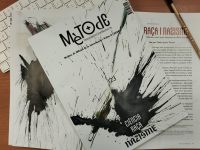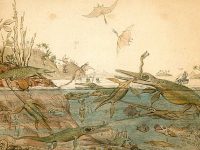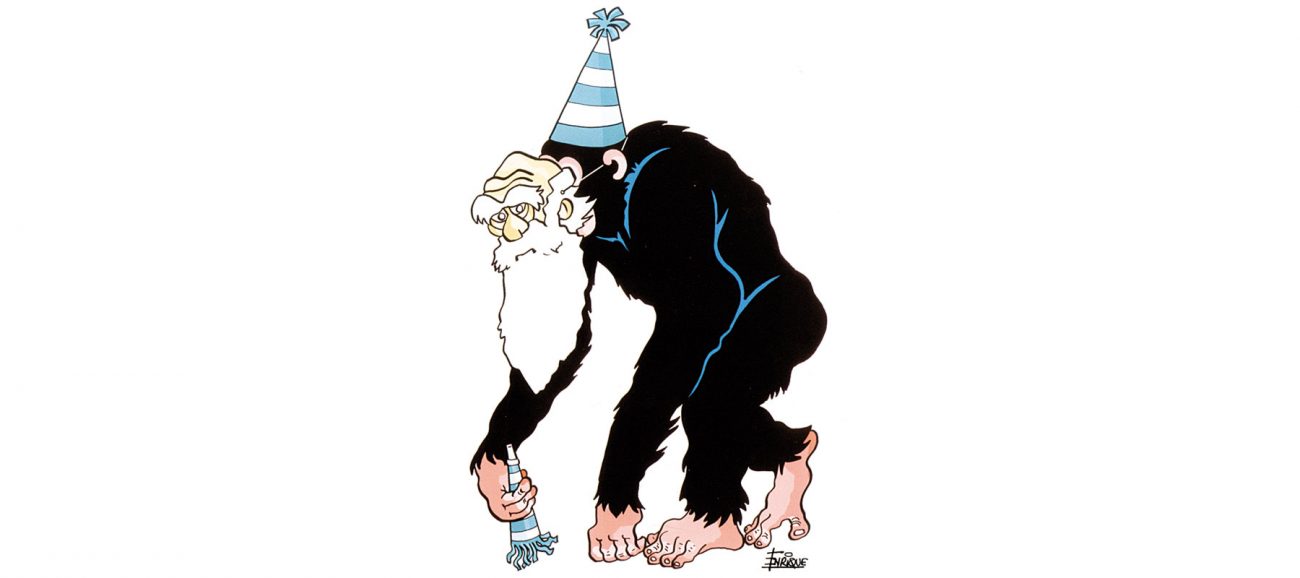
The Year of Darwin, held in 2009, demonstrated that everything surrounding the British scientist still continues to spark interest (and stir up controversy) in our society. Both the Spanish and the international press echoed the 200th anniversary of Charles Darwin’s birth, placing emphasis on the debate between science and religion. Even today, his theories accrue supporters and detractors alike, and it is mostly the religious implications of his work that come under attack. Evidence of this can be seen in the fact that creationism is welcomed by some communities in the United States, a trend which is not unknown in Europe either, albeit to a much lesser extent.
«Darwin has become the icon of modern biology, and the celebrations held in 2009 contributed to a growth of this perception in public opinion»
Even so, in 2009 the press was undivided as to the importance Darwin and his theories have had for scientific progress. However, creationism was present in most news items when it came to depicting the bicentenary celebration. Indeed, the few criticisms aimed at Darwin came specifically from the religious standpoint, and found a place –albeit in a minority– in some conservative Spanish newspapers, like El Mundo or Abc.
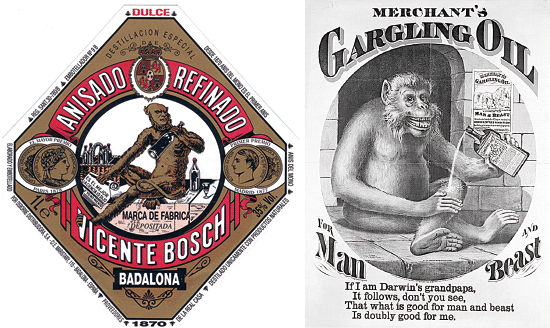
The impact of Darwin’s theories has made this scientist form part of the collective imagination. Advertising took advantage of this popularity and used the naturalist’s image in adverts and brand logos. One of the best known examples is that of Anís del Mono, which sported an ape like Darwin on the bottle’s label. Merchant’s Gargling Oil also used an ape, who claimed to be Darwin’s grandfather: «If I am Darwin’s grandpapa, it follows, don’t you see, that what is good for man and beast is doubly good for me». / Mètode
But apart from the news articles, reports and opinion columns devoted to the scientist, the figure of Darwin also found a special place in comical cartoons. Over these two hundred years his image has become such an icon of science that he is easily recognised by the general public, and thus he has made his presence felt in graphic humour. This relationship between Darwin, the theory of evolution and cartoons is not new. After the publication of On the origin of species, the scientist became a gold mine of inspiration for cartoonists and illustrators. The religious controversy and the idea that man evolved from primates were key issues, but Darwin’s new theory was also portrayed, and continues to be represented, as an analogy to criticise other aspects of society.
The characteristics intrinsic to cartoons, which are both humorous and satirical, make them an excellent medium for the critical analysis of reality. Moreover, their strong visual component transmits their message to the reader easily, rousing a spontaneous smile. Science is not immune to these cartoons, which juxtapose the rationality of scientific thinking with the absurd or shocking scenarios proposed by the cartoonists.
From satirical magazines to advertising

On 1880, the French satirical magazineLa petite lune published an apelike caricature of Darwin on its front cover. The idea that humans descended from apes was the part of Darwin’s theory that most shocked nineteenth-century society, and was taken up by satirical magazines and newspapers to ridicule the scientist. / Mètode
When the first edition of On the origin of species, came out in 1859, the press immediately echoed the debate sparked between science and religion. According to mainline religious beliefs, God created the world and all the life forms it harbours, just as we know them today. Thus the theory of evolution shook the very foundations of the religious world.
One of the claims that most shocked society at that time was man’s alleged common ancestry with apes. It was not long before Darwin began to appear caricatured as a monkey in the satirical press of the time, such as Hornet Magazine, La petite lune or Punch. In just a few years, these cartoons became very popular and were even taken up by commerce and advertising. The best known case is perhaps that of Anís del Mono, liquor, which –by 1870– sported an image on the label showing the father of the theory of evolution caricatured as an ape, holding up the slogan «It’s the best. Science says so, no kidding».
But this was not the only brand to use the monkey image to advertise its products as this was also the case of Frank Miller’s Shoe Blacking and Merchant’s Gargling Oil, which also got on the bandwagon of the social impact of Darwin’s theories. In fact, Merchant’s made direct reference to the scientist, promoting its mouthwash with an ape who claimed to be Darwin’s grandfather, the caption read: «If I am Darwin’s grandpapa, it follows, don’t you see, that what is good for man and beast is doubly good for me». Thus Darwin came to form part of the collective imagination.
Meanwhile, the Spanish press did not stay out of the debate either. So, in the mid-nineteenth century, we saw magazines like La Abeja taking up a position openly in favour of the theory of evolution. Conversely, publications like El Museo Universal chose to ridicule Darwin’s thesis through satirical cartoons and articles. Thus, in June 1863, the magazine published a cartoon entitled The origin of certain animal species,in which a man –possibly Herbert Spencer or Charles Darwin himself– evolves into a donkey.
Evolution, religion and creationism
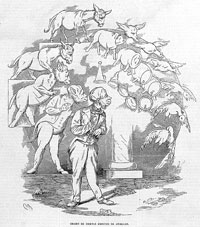
Illustration published in El Museo Universal in 1863 with the following caption: «Our drawing today depicts a recent case that occurred somewhere in Europe, in a country whose name we do not care to remember. A certain individual chose to go where he was not bidden and stick his nose into what did not concern him, he also wished to speak about what he did not or could not understand. He talked about philosophy, religion, politics, elections, influences and he raved on to such an extent that so much sharpening of the ear made it grow long; his neck elongated to a disproportionate extent, while his forehead shrunk; his face began to fall as his ears went upward; and his body became rounded like a barrel, until he turned into an ass. He continued to insist he was a man by dint of braying when, as punishment, Providence made him bray so, that his head escaped him and turned into a goose. Eloquent lesson for those who talk about what they do not understand, go where they are not bidden and stick their noses into what does not concern them, and are often vulgarly called jackanapes». The cartoon character could be the naturalist and evolutionist Herbert Spencer or even Charles Darwin himself. / Biblioteca Virtual de Prensa Histórica (MECD)
A century and a half after the publication of On the origin of species Darwin continued to arouse a great deal of interest in the media, and fed the imagination of cartoon artists. Throughout 2009, Spanish newspapers like El País, El Mundo or La Razón, or international newspapers like The Times or The New York Times, published cartoons depicting the English scientist and the many controversies raised.
The most frequent subject taken up by cartoonists was the debate between evolution and creationism. Thus, Adam and Eve, God and other religious figures were to be found sharing cartoons with Darwin and other scientists, mainly revealing a critical view of how religion interferes in scientific affairs. This was also the theme chosen in the III Exhibition of Graphic Humour organised by the Valencian Journalists’ Union and Spanish cartoonists’ federation FECO España. The exhibition was entitled Creation or Evolution? and gathered together 223 participants from 44 countries, who brought out the amusing side of this controversial issue.
In the Spanish press, Manel Fontdevila and Miquel Ferreres in Público, and Forges, in El País, addressed this issue in their cartoons, juxtaposing scientific logic with religious dogmas. Internationally, cartoonists such as Zapiro, in The Times, Rainer Hert, in Eulenspiegel, and Nicolas Vadot in Le Vif/L’Express, also reflected the clash between religion and the theory of evolution. In many cases,the cartoonists went a step further, criticising the reluctance of religion to accept scientific progress.
However, in contrast to this critical view of religion the conservative dailies, and those having close ties with the Catholic Church, chose not to enter into this debate in their comical cartoon strips. They did not mention the controversy between science and religion, but rather took a cautious approach to the theory of evolution, perhaps even playing down its importance. Thus, for example, Abc ‘s cartoonist Mingote drew an ape proclaiming: «It’s impossible that this species descended from ours. We can’t possibly have degenerated that much!» This ironic perspective of evolution was shared by cartoonists in La Razón and El Mundo), who portrayed humans as less evolved than the ape, making the theory seem absurd and implying that man did not descend from monkeys.
The theory of evolution was largely present in the cartoon strips published during the bicentennial celebration of Darwin’s birth, which often portrayed the idea that species adapt to overcome the struggle for survival, and that evolution is progress. Thus, in El País, Romeu portrays two characters discussing Darwin’s anniversary: «Two hundred years of Darwin, 150 years of On the origin of species, and the human race is celebrating it by ceasing to prosper». Cartoonist El Roto, meanwhile, preferred to highlight criticism of the arrogance of the powerful, drawing a Tyrannosaurus saying, «An expert told me that only the largest will survive».
Darwin, the scientist
Darwin’s image has become one of the most charismatic icons of science. Indeed, few scientists enjoy such popularity, comparable –perhaps– only to that of Albert Einstein, as both had a huge impact on the society of their respective epochs, reaching beyond their contributions to the advancement of science. The German scientist’s dishevelled hair was to become his main hallmark, while Darwin’s beard –easily recognised by the public– was adopted as the iconic element associated with this historical figure.
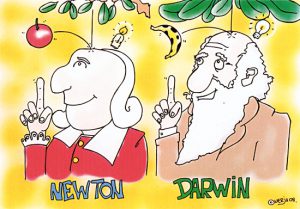
Darwin has become one of the scientists most easily recognised by the public. In this respect one can speak of the naturalist as an icon of science, along with other figures such as Albert Einstein or Isaac Newton. Concerning the latter, in 2009 the cartoonist Nerja drew an analogy between Newton and the apple, on the one hand, and Darwin and the banana, on the other. / Manuel Sánchez Nerja
The English naturalist stands out in the cartoons for his calm and thoughtful air. Darwin is considered a great scientist and a great intellectual, and cartoonists like Forges used this image to turn the spotlight on many of the defects or excesses troubling current society. Thus, we see Darwin pensively contemplating or surprised by the cruelty of bullfighting, creationism, the European elections or the European legal system. In this respect Forges transforms Darwin into a rational figure of high moral standing due to his intellectual stature, and pays homage to him through a series of cartoons published in El País.
The pictures of Darwin are often accompanied by other symbolic elements, such as bananas, which are easily identified with apes. The artist Manel Sánchez Nerja used this element to draw an analogy between Darwin and the banana, on the one hand, and Newton and the apple, on the other. The latter is another iconic scientist, although in this case the apple gains prominence over Newton’s physical appearance.
Be this as it may, Darwin is most often caricatured or accompanied by an ape, an image previously used in the mid-nineteenth century, as we have seen. Thus we find cartoon strips in which God is depicted as a great ape, or Darwin himself is drawn with apelike features. Some cartoon artists, like Carcayú (Borja Prieto Coscollà), take the irony and humour to the limit, and draw Darwin in the church marrying an ape decked out in a wedding dress, before a shocked priest.
Icon of modern biology
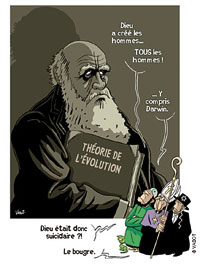
A century and a half after the publication of On the origin of species, Darwin still sparks debate among the major religions. During the Year of Darwin, cartoonists reflected this controversy between science and religion in much of the world press. This was the case of Nicolas Vadot’s cartoon in Le Vif/L’Express, showing three different religious confessions talking about Darwin: «God created all men! Darwin too». A statement the cartoon characters reflect on saying: «God was suicidal, was he? What a fool…» / Nicolas Vadot
The publication of so many comic cartoons, together with the press coverage of the Year of Darwin, reveals that this scientific figure continues to be of relevance in our society. Furthermore, just as the nineteenth century cartoonists reflected the controversies surrounding Darwin, so current newspapers have highlighted the importance of this historical figure one hundred and fifty years later.
However, there is a difference between the cartoons published after 1859 and those published today. In the past, the figure of Darwin and his theory were ridiculed, whereas now there appears to be broad consensus on his scientific importance. The cartoons portray Darwin as an emblem of progress and science, to be looked up to as an example. Thus, Darwinian iconography has also been used to attack political –generally conservative– leaders such as George W. Bush and José María Aznar.
The cartoon strips that reflected the debate between creationism and the theory of evolution clearly did so from a standpoint criticising religious dogmas, supporting and validating Darwin’s ideas. The conflict between science and religion was more overtly depicted in the progressive newspapers, while the conservative papers chose not to enter into this debate, and kept their distance from the theory of evolution, without questioning it openly.
All told, Darwin has certainly become the icon of modern biology, and the celebrations held in 2009 contributed to a growth of this perception in public opinion. Nevertheless, the figure of Darwin still continues to stir up debate, but –unlike a hundred and fifty years ago– his ideas definitely seem to be accepted by the vast majority of Spanish society.
References Barberà, Ó. et al., 2009. «Darwin als quioscos. La faula del goril·la i el cavall marí». Mètode, 60: 86-94. Browne, J., 2001. «Darwin in Caricature: A Study in the Popularisation and Dissemination of Evolution». Proceedings of the American Philosophical Society, 145(4): 496-509. Díez, E. et al., 2009. «Darwin in the Press: What the Spanish Dailies Said About the 200th Anniversary of Charles Darwin's Birth». Contributions to Science, 5(2): 193-198. Domínguez, M. i A. Mateu, 2012. «Spanish Darwinian Iconography: Darwin and Evolutionism Portrayed in Spanish Press Cartoons». Public Understanding of Science. Prepublished 17 May 2012. DOI: 10.1177/0963662512442050. Gomis, A. i J. Josa, 2002. «Iconografía Darwiniana en España». In Puig-Samper, M. A. et al. (eds.). Evolucionismo y cultura: Darwinismo en Europa e Iberoamérica. Junta de Extremadura, Universidad Nacional Autónoma de México, Ediciones Doce Calles. Madrid.


